Dave Severns ballscreens
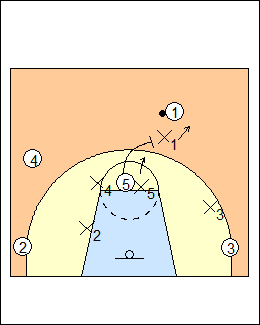 | 1 Dave Severns (LA Clippers) jymratt.com Pick and roll defence is a 5-man, team responsibility. The most-common ways to defend ballscreens are - show - soft - blitz - switch - down. The big (screen) defender must call the coverage early, loud and often (3 times), which signals to the guard when and how to adjust his stance. The guard cannot peek to see where the screen is coming from, the big's voice is his eyes. The guard's pick-up point is usually a step or two above the 3 point line, he plays the ball square (not allowing middle or baseline penetration) and controls it until he hears the call, then he must jump into the ball - adjust his stance, and press up into the ball (not back off). The guard must pursue the ball (not melt on the screen), squaring it up as quickly as possible. Getting the top leg over the screen and fighting through to get back in position is difficult. The best defensive guards can get over and avoid being screened, nullifying the ballscreen. The big may end up guarding the ball for 1-2 dribbles until the guard can square it back up, at times it may be too late and a "late switch" must occur, the big breaks off the coverage and guards the ball, the guard veers off and guards the screener, putting him in a vulnerable rebounding position. |
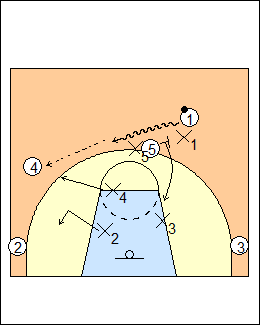 | 2 X3 defending 3 in the corner from which the ball is going opposite is crucial, he must be "in to get out". As the ball starts to go away he must be in early (foot in the paint and up the lane) to bump the roll. Weakside defenders X4 and X2 should also be "in to get out". X4 is in a help position on the nail or elbow, ready to close out on a pass to 4. Corner defender X2 is ready to stunt for X4 as a pass to 4 is in the air, then already be going back to his man. The stunt gives 4 the appearance that X2 is rotating to him, and can disrupt his timing. |
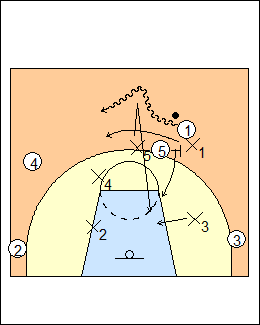 | 3 1) Show Re-direct the ballhandler towards half court. Defensive big X5 must thrust out, with his numbers to the sideline, inside hand down to deflect the pocket pass, then high hands back to the screener. X1 gets into the ball and fights over the screen, going under X5. Ettore Messina - as a general rule, hedge and recover without switching. If X5 is perpendicular to 5 (a flat hedge), this will slow the dribbler but allow 5 to roll towards the basket or pop to one side, making defensive recovery more difficult. Del Harris - avoid "stringing out" too far in showing/hedging (more than 1-2 steps), forcing a rotation on the screener. Recover toward the lane. |
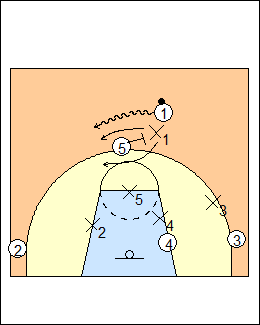 | 4 2) Soft On a high (middle) ballscreen, screen defender X5 is back in a soft position, almost "corralling" the ball until the guard can get back in front. X1 can go under or over the screen, depending on the scouting report or how high the screen is out on the floor. Use the pick and roll wisely, don't overuse it. There are five pick-and-roll angles - side, middle, step-up, elbow (horns), angle - the most effective are middle, elbow and angle (up from the elbow toward the sideline). Teach the re-pick option, when they use the first one, have them come right back and use a second one, with the same screener both times. To use the re-pick as a set play, the first pick is a sloppy one to set up the second one that will be in closer. Messina - go underneath against non-shooters or when the screen is far outside the 3-point line, the screener is usually coached to re-screen, giving the dribbler a new line of attack, to counter, the screener's defender should hedge after the re-screen. Kevin Eastman - twist ballscreen - use the same coverage on the first and second screen (re-screen). Go weak in the middle of the floor. Thad Matta - hard hedge or flat hedge horns action, tag the roller from the weakside corner. Harris - too much pick and roll stifles ball movement and the penetration game. Defending elbow area picks, - show hard and stay high to cover a pick and pop or roll and replace (if you show hard, your man will roll to the basket and have to be picked up by a teammate) - show at an angle to the corner (down the line, no more than a step) to slow down the ball and stay in the passing lane to the roller, weakside help is vital. |
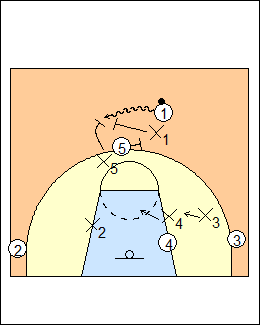 | 5 3) Blitz A hard trap with the defensive guard and big. Messina - double-team a very good player, force a pass. Steve Wojciechowski - a great trapping situation is when the screener is not a great shooter, someone who will always roll to where your three helpers are waiting. Rick Pitino - trap a pick and roll below the 3-point line, X5 hedges out and traps with X1, other defenders will have to rotate over to the roller, a pass should not be easy as there should be good ball pressure. Above the 3-point line, hedge out with X5 and go behind. |
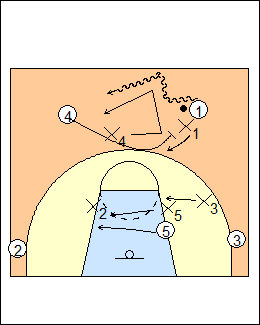 | 6 4) Switch Usually an aggressive jump switch to make the ballhandler pick up the dribble or go away from the basket, almost always done in a low-clock situation. Wojciechowski - the switch is flat, not a jump switch. Matta - switch screens 1-4. Harris - the best defence against ballscreens is to switch the switchable ones. You will normally want to have a trap option, and may want an aggressive option for your athletic screen defenders and a more containing one for slower big players. The easy way out is to have only one or two ways. Offensively, a "drag screen" is a common and easy way to get into pick and roll on a make or miss in transition. It usually happens in the "slot" area halfway between the sideline and pro lane line. The screener touches the top of the 3-point line then sets the screen with his butt to the basket, giving the guard a downhill angle to attack, and forcing X1 to trail. 5 can replace above the elbow area from the ballside block when (if) 4 rolls (roll and replace), mirror the ball ("short" or "flood" action, shown), or be lifted in the opposite slot area (above the 3-point line) to create spacing for the roller to get to the rim. (Variations) - 5 ducks in from weakside, see Offence - Tennessee playbook (late clock #3) - 5 gets to or stays at the ballside block, see Offence - Matt Bollant dribble-drive, Fast break - Nets (2 can backcut). Also see Fast breaks - Triano early offence (drag), Phoenix Suns drag screens. |
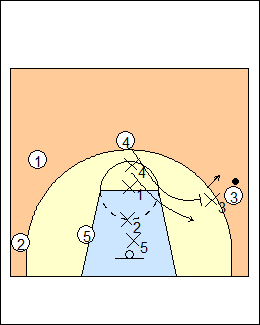 | 7 5) Icing / Downing Re-direct the ball towards the baseline. Icing or downing shrinks the court and makes it difficult to reverse the ball. The Clippers like this coverage in both side and angle ballscreens. X3 is square to the ball until he hears X4 call "ice/down" (early, loud, continuous), then gets into the ball and forces 3 to the baseline (don't let him reject it to the middle). X3`s right hand is down and ready to deflect the pocket pass to 4 who may be at the elbow or has popped back. Most teams usually play it with X4 up (near the screener) or back (to protect the paint), the Clippers believe that up is best. a) Up - X4 is within touching distance of the screener, in a stance, down, wide, vocal, active and aggressive, making the offensive guard think about whether to attack (many times the guard will actually back dribble). X4 has his left hand down to deflect a pocket pass, and discourage a cross-grain dribble back to the foul-line area. b) Back - some teams have X4 back to protect the paint (Duncan) and give up a 2-point shot, the Clippers feel that this shot is too many times uncontested (X3 must contest from behind). Back is also vulnerable to a foul on X4 as X3 attacks him, and a quick pocket pass to 4 at the elbow leaves him briefly unguarded. Weakside defenders X1 and X2 must be in to get out ("accordion"), camped out on the "weakside i". X1 is on the nail, ready to stunt or possibly rotate if 4 is a shooting big (Dirk) who has popped back for a shot. Harris - turning the pick and roll down is a good change-up, but don't overdo it. X3 must quickly jump to the high side of the ballhandler but only slightly higher than parallel with the sideline, not turned too far toward the baseline because it encourages a split. X4 must get between the ball and the basket but no more than two steps away from 4, down in defensive stance, able to move his feet. Biggest concerns are getting split, and a quick pocket (bounce) pass to 4. If 4 is not a good shooter, a short pass on a pick and pop is not a problem, X4 can help and recover, X1 on the nail should at least stunt (but not leave 1). If 4 is an adequate shooter, X1 rotates to 4, the rest of the defence rotates up a man, and X4 goes low weakside to pick up. |
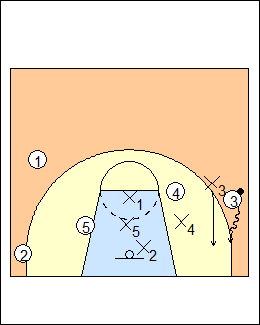 | 8 Once he has forced the ball down to the baseline, X3 must try and get back in front and square the ball again (pursuit). If 3 picks up his dribble, X3 gets his hands up to encourage a "hang time" pass, allowing the weak side to recover while the ball is in the air. Some teams play "ice/down" with only the 5 defender, some with both the 4 and 5 defenders. Offensively, for a swing pick and roll, 1 passes to 4 who swings it to 3 and immediately follows into a side pick and roll. Messina - 4 is not a good shooter, force 3 where there are not many passing lanes available. X4 is parallel to the sideline and perpendicular to 4 (not allowing 4 to cut in front), arms out, ready to stop any penetration by 1 and recover to 4 on a pass. If 4 is an average shooter, a rotation should not involve X5. Harris - if the ball is penetrated X4 tries to defend both players as long as he can, by dropping down the line toward the goal. X3 tries to recover back in front, but X4 must be ready to commit to the ball if he has to (trap or late switch). On a late switch, X3 gets between 4 and the ball if possible, the low weakside defender gets to the roller, takes him, and yells for X3 to go weakside and find a man to put his body on. If 3 beats X3 and X4, the low weakside must attack the layup. If you are a zone team, turn all wing or corner pick and rolls down, switch top and elbow pick and rolls. See Defence - Procopio ballscreens.  |
This page was made with Basketball playbook from Jes-Soft